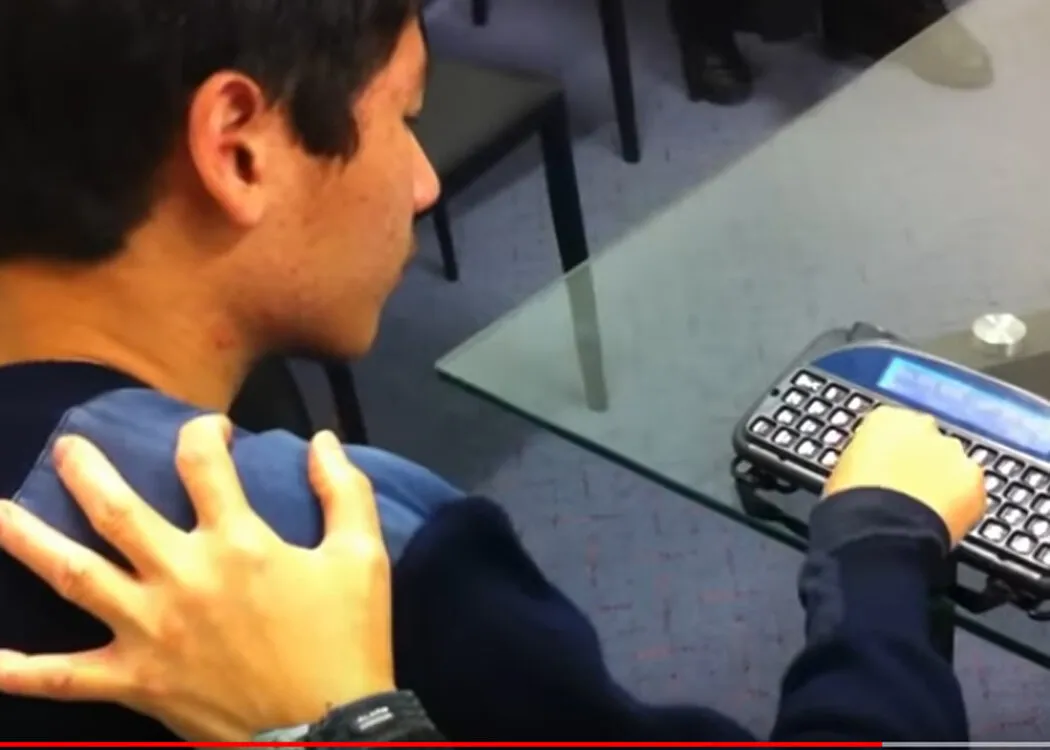Facilitated Communication
Hamish Dickson - 5th February 2024
This article is a brief introduction to facilitated communication (FC) - what it is, and what harm it can do for a person being facilitated. I will also give some guidance on what you can do to help.
Facilitated communication (FC), sometimes known as assisted typing, is a scientifically discredited method used to help non-verbal people communicate. The technique involves a facilitator who guides the non-verbal person’s hand over a keyboard or letter board, and the disabled person is then seen to type out words or even complete sentences. The disabled person is apparently unable to complete this task without a facilitator.

Numerous studies have indicated it is actually the facilitator who is responsible for the communication, and not the person who is being assisted. These studies often employ split screens, where the facilitator is presented with a different image to the person being facilitated. It is always the facilitator’s image that ends up being communicated. Also, spelling mistakes and grammatical errors usually match the facilitator’s writing style.
The difference between FC and other modes of discredited mumbo jumbo is that, in this case, the facilitators are largely not trying to deceive anyone. They often have good intentions, and are genuinely trying to help the person communicate. What is going on here is similar to what happens when Ouija boards or divining rods are used; the ideomotor effect. The ideomotor effect describes an unconscious action or movement in a desired direction. A facilitator often gets the impression that it is the non-verbal person controlling the communication, with their help, where it is in fact themselves who are in control.
In some cases, over time the facilitator gradually moves their hand further up the person’s arm, ending up at the shoulder. This looks rather impressive, as it looks less like the person being facilitated is not being influenced at all. This usually turns out not to be true, as the person being facilitated has learned to sense changes in pressure from the touch of the facilitator. These changes in pressure (pushing against the person’s back or neck, releases in pressure, pulling on clothing, etc) signal where on the letter board to hover one’s finger and/or press down on a key.
The facilitator can also unwittingly add cues, such as tapping the feet of the person with their foot, or providing subtle audio cues or other bodily gestures. For a detailed article on the role of touch in FC, this is well worth a read:
http://gwald.com/dl/Kezuka1997.pdf
There have been several cases where a person “aided” by FC has “earned” degrees, gone to conferences and given talks. It has been seen as a way of freeing a person of their disability, and has even been championed as the best thing for disabled people in history.

So, if it doesn’t actually work, what’s the harm? The harm can vary, and is often profound. In its early years, family members have gone to prison solely based on testimony through FC. Fortunately, such testimony is no longer considered evidence in a court of law. Much of the harm is levelled directly at the non-verbal person.
Probably the biggest disservice FC can have for a non-verbal person is that it paves the way for that person to be turned into an avatar which is controlled by the desires and ambitions of the facilitator. This can include being deprived of things they like, and given things they don’t like. For example, going to the pub with lots of people around and consuming alcohol because the facilitator thinks it’s fun, or sitting through boring lectures at a university. Disturbingly, there have been reports that it has also been used to validate consent to sex by a facilitator. It has meant, in one case, a non-verbal person was on an unemployment benefit rather than an invalid’s benefit, as the facilitators thought that he was a genius, just misunderstood. This meant this person received substantially less money for medication and other needs. In other words, FC can force a person to live a fictional life they are not happy with.
Other harms can include creating barriers to being able to use scientifically valid means of communication. After several years of using FC, often starting at a young age, appropriately qualified persons may come along and try to use validated strategies for communication. The non-verbal person, used to using FC to “communicate”, will just tap any piece of paper or photo at random, as this to them is what has been happening for the last several years. I have personally worked with one person who, even after over a decade of not using FC, often resorts to randomly touching picture cards in the same way. This can be easily tested, like in this instance using pictures of two objects; raw broccoli and chocolate. The person communicating would get to eat a sample of whichever one they choose. And the results are a random selection each time - and no, this person doesn’t like broccoli!
So, you get the idea. Not only does it not work, but it’s also harmful. So what can we do about it when we know of someone who is using this method? My advice is to tread carefully. Often the facilitator is a parent, and will have a great deal of emotional involvement. Cognitive dissonance can be very high. For example, many non-verbal people undergoing FC are not even looking at the keyboard, but staring at the ceiling or floor. When asked about this, the parent will just say something like, “they have profound peripheral vision”. Sometimes it is best to just ask them if the method is controversial, encourage them to explain why, and leave it at that.
Thankfully, most often, a non-verbal person will be in a supported living arrangement with an organisation who does not use FC, due to it being pseudoscience. In these cases, there is little point in trying to prevent FC being used, as they will have little exposure to it, and any damage has likely already been done. If you see an academic institution teaching Facilitated Communication, please report them to the NZQA. Academic institutions should know that it’s BS, but some provide courses on it anyway. Fortunately I am not aware of any occurrences in NZ, but there are definitely some in the US.
In the event that NZ adopts a user-governed system in the future, where families will be able to choose a provider and pay for a service, FC training courses may pop up to capitalise on this. User-governed systems are currently being implemented in European countries, and this is likely to be the norm in NZ in the coming years - it is already being implemented, to a small degree, in Aotearoa.
The bottom line is, be kind. The people who are using FC are overwhelmingly likely to have the best intentions for the person being facilitated. They have just been taken in by the ideomotor effect and a desire to improve the lives of those they love. If you are interested in learning more about FC, there are some really good videos by Janyce Boynton at:
Janyce was once a facilitator herself, and is now very much a skeptic. She was kind enough to help with some of the resources used in the writing of this article.